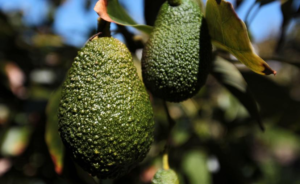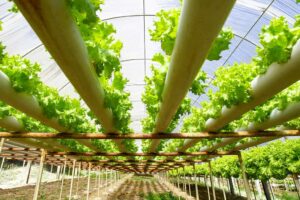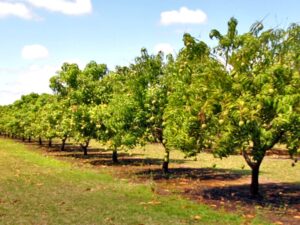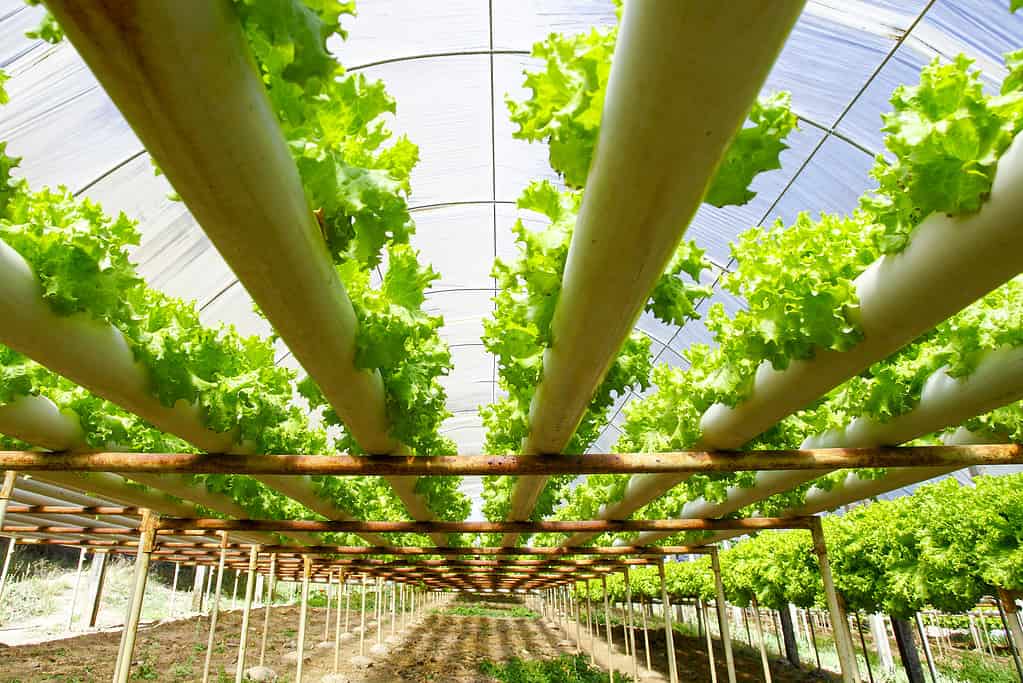
Lettuce is a very popular vegetable. With so many different varieties, such as romaine, green leaf, and butter lettuce, the options of this leafy green seem endless. Commonly used as salad bases, shredded on top of tacos, in soups, or as wraps, there is no shortage of how people use this vegetable. However, lettuce is a cool growing crop that thrives in fall and spring. What about the freezing or blistering heat seasons? How could you get fresh lettuce, then? Luckily, there is another way. Lettuce is one of the best plants that you can grow hydroponically. This article will provide you with a complete guide on how to grow hydroponic lettuce.
The word hydroponic comes from the Greek language. The Greek word “hydro” means water, and “ponos” means labor. The National Agricultural Library says, “ Hydroponics is the technique of growing plants using a water-based nutrient solution rather than soil.” When using this method, the plants derive their nutrients from aggregate substances or mediums used to support the roots of plants. Common choices for this medium are coconut coir, also known as coconut fibers, vermiculite, or perlite. These materials and minerals help to provide efficient nutrients to the plant as it grows.
Hydroponics can be done with or without the use of artificial mediums. In addition to those mentioned above, common mediums are expanded clay, brick shards, and wood fiber. Small farmers, hobbyists, and commercial enterprises use hydroponic production systems. People now recognize it as a viable method of producing vegetables, and the demand for it has increased because of bans on soil culture.
Are Hydroponics the Same Thing as Aquaponics?
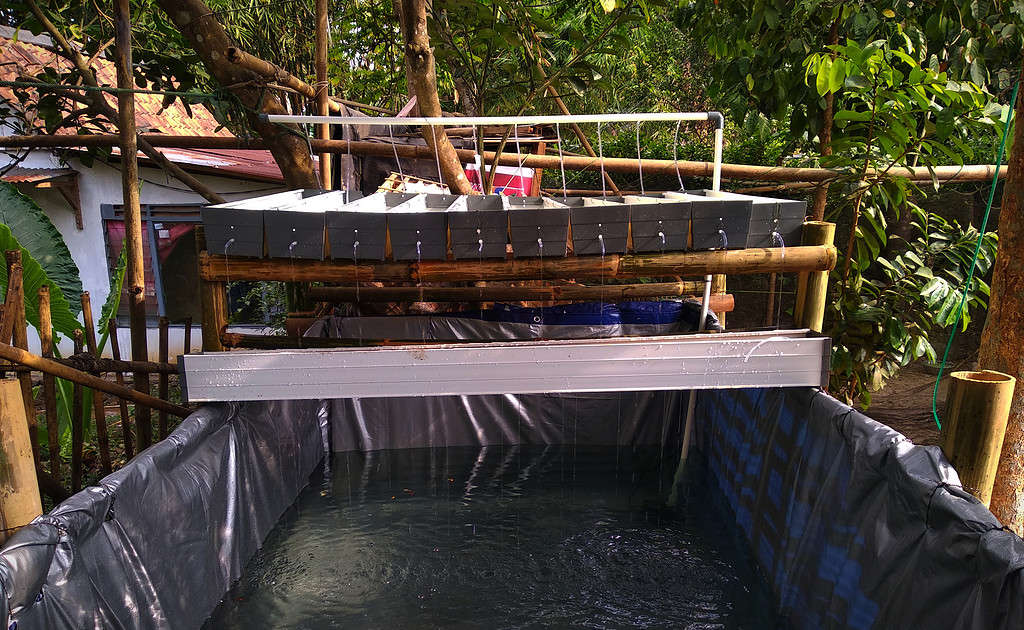
Another type of growing system that is often confused with hydroponics is aquaponics. While both systems use water and differ from soil growing techniques, they are not the same. Aquaponics combines aquaculture and hydroponics. NOAA describes aquaculture as “the breeding, rearing, and harvesting of fish, shellfish, algae, and other organisms in all types of water environments.”
With aquaponics, the system is usually built on layers. There are fish in the system that eat and produce waste. That waste is converted into nitrates, which act as a fertilizer fed to the plants. Hydroponics only uses plant nutrients; there are no fish involved. This is one of the main differences between hydroponics and aquaponics.
Why Use Hydroponics for Lettuce?
Lettuce is one of the best plants that you can grow in water. As an annual plant, lettuce can only survive outdoors, in the proper conditions, for so long. Hydroponics allow you to grow this vegetable year-round. Hydroponics takes out many uncontrollable factors from the outdoors, such as soil-related insects and fungi, as well as the weather. In addition, you can harvest the leaves over and over again. Finally, growing lettuce hydroponically requires very little space. Also, you can choose to grow them in vertical or horizontal systems.
The Pros and Cons of Growing Lettuce Hydroponically
| PROS: | CONS: |
|---|---|
| Can be used in places where in-ground agriculture is not easy or available (Ie. deserts). | Initial costs are higher than with soil culture. |
| You have more control over the nutrients your plant is getting. | Upkeep and operational costs are higher. |
| Faster growth rate. | You need to take the time to learn the skills and knowledge of hydroponics. |
| You don’t need to worry about soil-related insects, fungi, or bacteria. | Some diseases still affect plants that grow hydroponically, and they can spread quickly and easily through the system. |
| You do not need to weed. | |
| Transplant shock is reduced. | |
| Long-term costs are more cost-effective (you can recycle water and nutrients). |
Different Systems for Lettuce
When it comes to growing your lettuce hydroponically, you can select two system choices: liquid or aggregate. The main difference between the two systems is that liquid systems have no supporting medium for plant roots. Aggregate systems have some solid medium to support the plants. Below are different types of each system you could use to grow your lettuce.
Nutrient Film Technique
The nutrient film technique of NFT is a closed system liquid hydroponic system. With this system, plant roots are placed into tiny slits cut into a polyethylene tube. A nutrient solution is pumped through the tube to help the plant roots grow. Pumps circulate this nutrient solution through the pipe. If you are a beginner with hydroponics, this may not be the best system for you. It is a more advanced system than the drip and other systems. Water runs down these pipes and goes directly to the roots of the plants. However, this is not a giant gush of water. Instead, it is a shallow stream of water that contains all of the required nutrients for the plant to thrive. This water is then re-circulated in channels.
What you would need:
- Grow Channel
- Your grow channel here would be the shallow tube.
- Water Pump
- This will be used to take the nutrient solution from the reservoir to the grow channel.
- Air Pump
- The air pump provides aeration and oxygenation to the nutrient solution.
- Nutrient Solution
- This can be your choice of nutrient solution. Some hydroponics experts consider nitrogen, phosphorus, and potassium essential ingredients for a nutrient solution.
Floating Hydroponics or Deep Water Culture

This is another closed liquid hydroponics system. In this system, plants grow on floating rafts. This system is also known as deep water culture but is often called floating hydroponics because it relies on floating rafts. The rafts are usually made of plastic. Water with nutrient solutions is pumped into the tank or chosen water feature. The floating rafts are on that water’s surface, containing small pots with a soilless medium. The plants grow in these pots on the floating structures, and their roots extend down into the tank with the nutrient water. Aeration of the water is needed here as well.
What you will need:
- Water Holding Tank
- Whether you make it a generic tank or a pond, you need somewhere to hold the water from which your plants will derive nutrients.
- Nutrient Solution
- You will need to have a nutrient solution added to the water tank.
- Floating Platforms
- You will need floating platforms or something to have the plants suspended above the water. A great option for this is a net pot, a plastic growing container with hotels at the bottom.
- Growing Medium
- You will need a growing medium of your choice to be added to the pot with your plant. Many hydroponic users suggest clay pebbles.
- Air Pump
- To oxygenate the water in the tank.
Aeroponics
The final form of closed liquid hydroponic systems is aeroponics. In this system, the plants are suspended in an enclosed chamber. In the chamber, they are sprayed with a mist of nutrient solution every few minutes. The main difference is that the roots are extended in the air, not into water. They are sprayed with a nutrient water mix. Whereas in the other systems mentioned above, they are submerged in water, and you need to be sure to add oxygen. They have plenty of oxygen here, and you need to remember to give them water.
Things you will need to build your own DIY aeroponic system:
- A Bucket
- A Riser (what is used to raise your plants)
- A Sprinkler
- A Pump
- A Timer
- Net Pots
The Wick System
Many people consider the wick system to be the simplest passive hydroponic system. In this system, the wick takes the place of the pumps. You have a reservoir with the nutrient solution, and the wick draws the nutrients up from it and into the tank filled with water and growing medium. In this system, the roots of the plants cannot reach the nutrient solution, so the wick acts as the channel between them. This is a system that can work without electricity and makes no noise.
What you will need:
- Reservoir Tank
- Plant Tank
- Nutrient Solution
- Grow Medium
- Plants
- Grow Tray
The Ebb and Flow System
People see this system as the compromise between the drip and deep water systems. In this system, you temporarily flood the grow tray with nutrient solution, then later drain that solution back into the reservoir. This flooding and draining action is usually done by a pump and is set on a timer to do so several times a day. This differs from other systems because the plants are not getting a continuous water flow. Instead, they are flooded every few hours to allow the roots to get wet, but when the water recedes, they have a chance to absorb oxygen.
What you will need:
- A Flood Tray
- Water Pump
- Timer
- Overflow Tube
- Reservoir Tank
- Grow Tray
- Air Pump
The Drip System

The drip system is probably the most widely used hydroponic system in the world. In this system, a time turns on a pump, and that pump drips nutrient solution into the base of every plant in the drip line. Here, your plants are in a grow tray rather than floating in water. You can add a soilless growing medium to your plant and drip the water and nutrients directly into it. This is a very water-efficient system and is a great choice for hobbyists.
What you will need:
- Irrigation Kit
- Drippers
- Tubing
- Pump
- Grow Tray
- Timer
The Best Lettuce for Hydroponic Growing

While many lettuce types are good for hydroponic growth, you are going to want to select the ones that give you the best return on your efforts. For example, loose-leaf lettuces like oakleaf, romaine, and butterhead have loose, compact heads. This makes it easier for them to fit into hydroponic systems. Common choices of lettuce for hydroponic growing are:
- Butterhead Lettuce
- Loose-Leaf Lettuce
- Romaine Lettuce
- Iceberg Lettuce
How Long Lettuce Takes to Grow Hydroponically
While the exact time can vary depending on which type of lettuce you choose to grow and which system you use, the average time of getting a head of lettuce ranges from four to six weeks.
While growing in the soil, maturation time depends on the variety of lettuce and environmental factors. Traditionally, lettuce usually takes between 30 and 70 days to mature.
Step-by-Step Instructions for Growing Hydroponic Lettuce

- Choose your type of lettuce.
- First, you must decide which variety or varieties of lettuce you would like to grow in your hydroponic system.
- Choose your type of system.
- Next, you must decide which hydroponic system best fits your needs. Regardless of your chosen system, your plants will still need the basic things. Those things are light and nutrient-rich water.
- Choose the growth medium you wish to use
- Select the growth medium you wish to add to your plants, and be sure to add it to your system.
- Prepare and Plant Your Lettuce
- If you are starting from seeds, plant them into your growing medium. If you are starting from seedlings, transplant them into your growing medium.
- Care for Your Lettuce
- Be sure to monitor and care for your lettuce and hydroponic system continuously. You can do things daily, weekly, and monthly to ensure you stay on top of your lettuce’s health.
- For daily maintenance, keep a journal. Monitor your plants and record all observations about them.
- For weekly maintenance, be sure to flush your reservoir systems and refresh your nutrient levels. During this time, check your system for leaks and repair if needed.
- For monthly maintenance, be sure to clean your chosen system properly.

